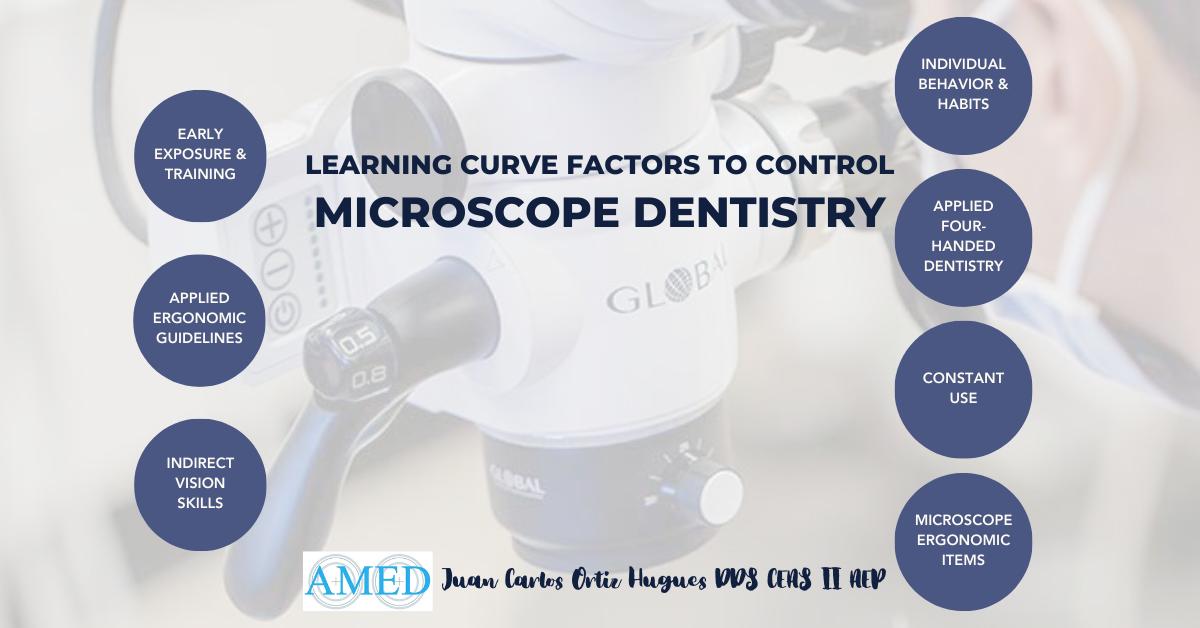Learning Curve Factors to Control Microscope Dentistry

This article outlines factors written by Juan Carlos Ortiz Hugues, DDS, CEAS, an Endodontist practicing in Panama. He is a Global microscope user and has recently published “Ergonomics Applied to Dental Practice” published by Quintessence. He lectures globally on ergonomics using a microscope.
Adopting microscope dentistry can be a transformative step for dental professionals, enhancing precision and improving outcomes in dental procedures. However, mastering the use of a dental microscope involves a learning curve that can vary widely among practitioners. Understanding and managing several key factors can help ease this transition, ensuring that dental professionals can leverage the full benefits of microscope dentistry efficiently.
This article explores seven critical factors that influence the learning curve in microscope dentistry.
1. Early Exposure and Training
The journey to proficiency in microscope dentistry starts with comprehensive training. Early exposure to dental microscopes during dental education can significantly ease the learning curve. Educational institutions that incorporate microscope training into their curricula provide new dentists with a foundational skill set that they can further develop in practice. Continued professional development courses and workshops also play a vital role in enhancing skills for those who were not exposed during their initial training.
2. Applied Ergonomic Guidelines and Work Practices
Ergonomics is crucial in preventing strain and injury over long periods of dental practice. Dental microscopes offer significant ergonomic benefits, but only if used correctly. Practitioners must learn and apply ergonomic guidelines specific to microscope use, such as proper adjustment of the eyepiece, correct sitting posture, and optimal positioning of the patient and microscope. Adhering to these ergonomic practices not only enhances comfort but also increases efficiency and focus during dental procedures.
3. Indirect Vision Skills
Microscope dentistry often requires dentists to perform procedures while looking at a screen or through an eyepiece, rather than directly at the patient’s mouth. Developing skills in indirect vision is a critical aspect of the learning curve. This skill involves hand-eye coordination and spatial awareness, which can be honed with practice and proper training.
4. Individual Behavior and Habits
Transitioning to microscope dentistry can be challenging for seasoned dentists who have developed specific habits and techniques over years of practice without a microscope. Changing these ingrained behaviors requires a conscious effort. Individual adaptability plays a significant role in how quickly a dentist can overcome the initial discomfort and become proficient in using a dental microscope.
5. Applied Four-Handed Dentistry
Four-handed dentistry, in which a dentist and a dental assistant work in tandem, is particularly effective when using a dental microscope. This approach maximizes efficiency and minimizes the need for the dentist to look away from the microscope. Training with a dedicated dental assistant who understands the specifics of microscope setup and operation can greatly enhance workflow and procedural precision.
6. Constant Use
Like any skill, proficiency in using a dental microscope improves with practice. Consistent and regular use of the microscope is essential to flatten the learning curve. Dentists should aim to use the microscope across a range of procedures, even those where magnification might not be essential, to build comfort and familiarity with the device.
7. Microscope Ergonomic Items
Investing in ergonomic accessories for the microscope can further ease the learning curve. These items might include customizable eyepieces, adjustable handles, foot controls for zoom and focus, and specially designed dental chairs that complement the positioning needs of microscope dentistry. Such ergonomic enhancements not only improve comfort but also enhance the overall efficiency of using the microscope.
Mastering microscope dentistry is a multifaceted process that involves more than just learning to operate the equipment. By addressing these seven factors — from early training and ergonomics to behavior modification and constant practice — dental professionals can effectively manage the learning curve. Embracing these aspects ensures that dentists can fully benefit from the enhanced visualization and precision that microscope dentistry offers, ultimately leading to better patient care and satisfaction.
Looking for More? Reach Out!
As a US-based manufacturer of dental microscopes sold worldwide, we know a thing or two about magnification & ergonomics. If you’re considering adding a microscope to your practice or you just want to learn more about utilizing a dental microscope, we are here to help! Please feel free to reach out at 800-861-3585 or by clicking the button below.


.png)
.png)